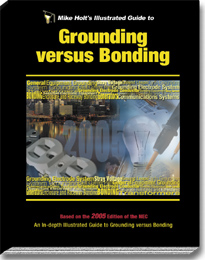|
Mike,
From 1991 to 1994 I did some research in the high voltage laboratory at Mississippi State University, which is shown at http://www.ece.msstate.edu/hvl/.
The project goals were to find out what happens to lightning current once it leaves the bottom of a lightning rod and heads down into Mother Earth, and also to find out whether the 60Hz current from a lightning-struck power line will follow that lightning current down into the earth.
The answers were that, at least in the sand we used, lightning current follows discrete paths very much like those that it follows in air (and, it turns out, in water as well) and that the power current from a struck power line will indeed follow the path of lightning from the power line, over the insulator, down the pole, out the lightning ground into the earth and thence to any good ground, such as a buried pipe.
Even though the lightning current is very brief and produces only a small pit in a buried pipe (we used half-inch electrical conduit,) the power line current that follows the ionized path produced by that lightning current will burn a hole right through a buried pipe. This is because the fault current from a power line through previously-ionized soil is limited only by the impedance of the power line. It continues to flow until the substation's instrumentation detects the fault and opens the circuit breaker, typically in a few cycles. The effect is rather dramatic.
We used 600kV impulses from a big Marx generator, which produces authentic lightning impulses as defined by IEEE. The power line current was supplied by a 15kV 'power follow' transformer, which has very low impedance and can supply very large currents. The role of the earth was played by a big dumpster filled with eleven tons of fill sand from the local gravel pit, and the lightning ground was a standard copper-clad ground rod. A fairly extensive computer simulation showed that, while the walls of the dumpster were in fairly close proximity to our ground electrode, this didn't affect the path taken by the currents.
The long literature review for the project shows that, over the years, many researchers have found that lightning currents obey their own rules and don't behave like the 60Hz currents that are the major concern of grounding experts like you. A good deal of work on the subject was done by Bell Laboratories in the 1940's (I think--I'll have to check the bibliography) and by various theoretical researchers and engineers through the 1980's, when the major concern was not lightning, but the electromagnetic impulses produced by nuclear weapons.
If you'd like, I can send you a copy of the journal paper we published and, if you have difficulty in sleeping, a copy of the graduate dissertation done on the subject. I'll also be glad to answer any further questions on the subject to the extent that I can. I believe that further research on the subject has been done since, but I'm afraid I haven't kept track of it to any great degree.
The reference for the journal article is "A Damage Mechanism: Lightning-Initiated Fault-Current Arcs" IEEE Transactions on Industry Applications, Vol. 35, No. 1, Jan/Feb 1999
Thanks for your newsletters. I enjoy reading them. You're performing a great service to the industry and to people everywhere by promoting safety in electrical installations in such an effective manner.
God bless, indeed.
Mark Kinsler, PhD
http://www.mkinsler.com
Mike’s Comment: Thanks Mark for taking the time to share this with me/us. Maybe someone reading this has more information and I’ll pass it along as well.
| Grounding versus Bonding Textbook |
 |
Grounding versus Bonding textbook is loaded with detailed color-coded graphics so you can easily differentiate between grounding and bonding. This text gets to the root of all problems associated with grounding and bonding. Subject includes: Circuit and System Grounding, Grounding Electrode System and Grounding Electrode Conductor, Enclosure, Raceway, and Service Cable Grounding, Bonding, Methods of Equipment Grounding, Direct-Current Systems, and Grounding of Systems and Circuits.
Product
Code: 05NCT2
Price:
$39.00 each

|
| |
|
|